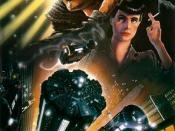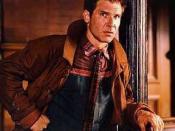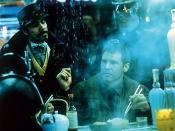Blade Runner is Ridley Scott's bleak and yet beautiful adaptation of Phillip K Dick's novel 'Do Androids Dream of Electric Sheep'. It was originally released in 1982 and was a box office failure. Despite this, the movie later achieved cult-status and the Director's cut was re-released in 1992. Blade Runner is widely thought to have been ahead of its time in its amazing futuristic vision.
Blade Runner is often referred to as a futuristic Film Noir due to its visual style. Lighting is usually the most distinctive feature of Film Noir, using highly contrasted areas of light and shade. The use of strong shafts of light as well as backlighting runs through the entire length of Blade Runner. Location is another important element of Film Noir: Dark cities, inhabited by low life, seedy bars and nightclubs, pitch black alleys with sudden shafts of light that reflect off the wet streets.
In the opening sequences of Blade Runner we see an aerial shot of the city. Though there are some lights the city seems to be covered in a blackness that is more than just the night. The streets are claustrophobic, crowded and dirty and though they are illuminated, it is not the warm orangey yellow lights that illuminate our streets today. Instead this world is illuminated by bright neon lights scattered everywhere casting an eerie glow on its inhabitants creating a sense of disorientation. There is a lot of backlight, smoke and rain in the shots of the streets creating a bleak outlook for the future.
The use of color is also very interesting in the street scenes as most of the people are wearing neutral tones making them all appear similar. Most of the color comes from the neon lights. This similarity in color hints at one...


